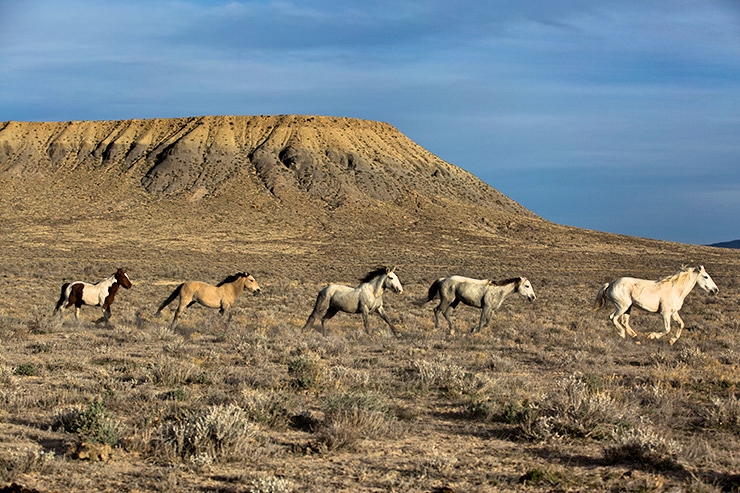
[paypal_donation_button]
While this trap-spay-return method is common and praised by animal rights groups for dogs and cats, a lawsuit against the spay research was filed by the Cloud Foundation and the American Wild Horse Preservation Campaign. The suit referred to the procedure as “highly invasive” and risky to the health of the mares. The BLM acquiesced and currently has no plans to spay mares.
story and photography by Ben Masters
Mustangs in Crisis
1. Fertility Control. The most commonly used method for fertility control is administering PZP (porcine zona pellucida) to wild horse mares. PZP can be administered with a dart gun and is fairly inexpensive. For it to work, the mare has to be given a primer, a booster one to two months later, and another booster every year after that. PZP is ideal for horse management areas (HMA) with reasonable access to the herd, a region that hasn’t already been overpopulated, and trained and dedicated BLM volunteers.
PZP programs typically succeed with a smaller herd because individual horses can easily be identified. Horses must be comfortable with humans so they can be approached to within 40 yards, the optimal range for an accurate dart-gun shot. However, an HMA that encompasses hundreds of thousands of acres and thousands of horses, it is very difficult to effectively administer PZP. Also, PZP doesn’t lower population sizes; it only slows the growth. It is an important long-term management tool, but it doesn’t have the capability of quickly reducing wild horse herds that are three, five or ten times over AML.
2. Trap-Spay-Return. In the spring of 2015, the BLM issued research funding to find the safest method to spay mares and then leave them on the open range. While this trap-spay-return method is common and praised by animal rights groups for dogs and cats, a lawsuit against the spay research was filed by the Cloud Foundation and the American Wild Horse Preservation Campaign. The suit referred to the procedure as “highly invasive” and risky to the health of the mares. The BLM acquiesced and currently has no plans to spay mares.
3. Adoption, Rescues and Sanctuaries. In 2015, 2,331 wild horses and 300 burros were adopted. About half of those were adopted through the Mustang Heritage Foundation’s innovative competitions and training incentives. The nonprofit organization has seen an increase in adoptions through its programs, finding homes for a record 1,200 animals last year and projecting to boost that number to 2,000 in 2017. Despite the positive figures, adoption numbers through the foundation and the BLM are down from 8,000 annually a decade ago to about 2,500 a year currently. While adoptions for riding, sanctuaries, and rescues will continue to be an important part of the wild horse and burro program, adoption numbers are a far cry from 10,000—the estimated number of new wild horses to be born in 2017, so adoption alone isn’t enough.
4. Euthanasia. In September of 2016 the volunteer Wild Horse and Burro Advisory Board voted 7-to-1 for the BLM to make horses in holding sale-eligible and to begin using euthanasia as management tool for excess horses. Although euthanasia is listed as a management tool in the Wild Horse and Burro Act and is a common practice for household pets, feral cats and dogs, and millions of privately owned horses annually, wild horse advocacy groups quickly condemned the decision. The BLM issued a statement that they would not sell or euthanize healthy horses. The subject was raised again in May when the President proposed his fiscal 2018 budget, and it met similar criticism. At the moment, euthanizing young, healthy horses continues to elicit outrage from various groups.
5. Sale Without Stipulation. If the BLM sold the excess horses without stipulation, there would be opportunity for horse sanctuaries and concerned individuals to obtain ownership. If the sanctuaries and individuals didn’t get the horses, they would likely be sold to a kill buyer who would arrange for their transport to a slaughterhouse in Mexico or Canada. Currently, there are no horse slaughter plants in operation in the United States. Sale without stipulation is the worst case scenario for many Wild Horse Activists because transportation to slaughterhouses can take days and the slaughter processes are not controlled by a U.S. authorities.
[wp_ad_camp_1]
6. Expanding Grazing Areas. According to a 2013 BLM forage allocation report, livestock and wild horse usage is nationally about one-to-one on the 31.2 million acres designated for wild horses and burros (1.1 million animal units per month, or AUMs, allocated to public land ranchers, versus 900,000 for wild horses and burros). Grazing practices for each group are quite different. The BLM permits livestock to graze at a regulated density in a certain area for a designated amount of time, while horses graze continually throughout the year and do not follow any type of structured pasture rotation. While it’s possible to allocate additional forage from livestock to horses in some areas, many livestock permits in HMAs have already been drastically reduced or eliminated, and many of those areas no longer offer abundant forage.
7. Culling. In Australia there are approximately 1 million brumbies, the country’s term for free-roaming horses. The Australian government hires marksmen to cull the herd. Similar practices are done in the United States for bison and elk. Although many groups consider culling to be the most humane method of population control, the BLM is not considering lethal culls as a management option.
8. Natural Regulation. Natural regulation is letting nature take its course. Unfortunately, that course has been modified dramatically as humans have built highways, erected fences, constructed dams, introduced invasive plants and animals and forever changed the ecology of the landscape. Allowing natural regulation to occur is a choice to enter wild horses into a boom and bust cycle. It can result in horses starving to death when resources become limited. Ecologists agree that not only would horses suffer, but wildlife, vegetation and everyone who depends on those landscapes would be affected negatively. Unfortunately, this is the direction the wild horse and burro program is headed. Although some of the above management options are in effect to some extent, experts agree that nothing has yet curbed the exponential growth of the wild horse population. Until the trend is reversed, two of the greatest treasures of the American West—wild horses and the public lands they roam—face an appalling future.
Free Range Report
[wp_ad_camp_3]
[wp_ad_camp_2]




It states that the BLM is not considering wild horse culling but does not state why. Is there a reason? Horse meat is considered a delicacy in many cultures. Why not sell it and use the money to finance herd maintainance programs.